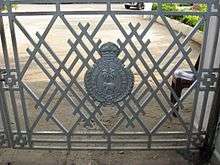Tudor Crown (heraldry)
The Tudor Crown, also known as the King's Crown or Imperial Crown, is a widely used symbol in heraldry of the United Kingdom. Officially it was used from 1902 to 1953 representing not only the British monarch personally, but also "the Crown", meaning the sovereign source of governmental authority. As such, it appeared on numerous official emblems in the United Kingdom, British Empire and Commonwealth.[1]
While various crown symbols had been used for this purpose for many years previously, the specific Tudor Crown design was standardised at the request of Edward VII. It was never intended to represent any actual physical crown, although in shape it bears a close resemblance to the small diamond crown of Queen Victoria.
Upon the accession of Elizabeth II, she requested the design to be replaced with a representation of the St Edward's Crown (with depressed arches) which she wore at her coronation. Many, though not all, of the derived designs around the world were updated to match.
In Canada, the Tudor Crown has been used since 1907 in the Canadian Government Inspection Legend on inspected meat products. The inspection legend (or symbol) consists of two concentric circles: the outer ring has the word "Canada" at the top and a number at the bottom identifying the place of production; the inner circle contains a black and white rendering of the Tudor Crown.
Gallery
 Royal Monogram of King George VI in London
Royal Monogram of King George VI in London.svg.png) Coat of Arms of the United Kingdom (1837-1952)
Coat of Arms of the United Kingdom (1837-1952)
.svg.png) Flag of Queensland (1901-1952)
Flag of Queensland (1901-1952)

 "Keep Calm and Carry On" wartime poster
"Keep Calm and Carry On" wartime poster Design element of Queen Elizabeth the Queen Mother's 90th birthday commemorative coin, 1990
Design element of Queen Elizabeth the Queen Mother's 90th birthday commemorative coin, 1990 Flag of the Colony of Natal (1843-1910)
Flag of the Colony of Natal (1843-1910).jpg) Scottish police cap badge (worn until 1975)
Scottish police cap badge (worn until 1975).svg.png) 1924 flag of Northern Ireland with Tudor Crown
1924 flag of Northern Ireland with Tudor Crown Pre-1954 crest of Royal College Colombo
Pre-1954 crest of Royal College Colombo Reverse of a 1953 half crown
Reverse of a 1953 half crown
See also
References
- ↑ Boutell, Charles (1864). Heraldry, Historical and Popular. p. 318. Retrieved 24 March 2015.
.svg.png)